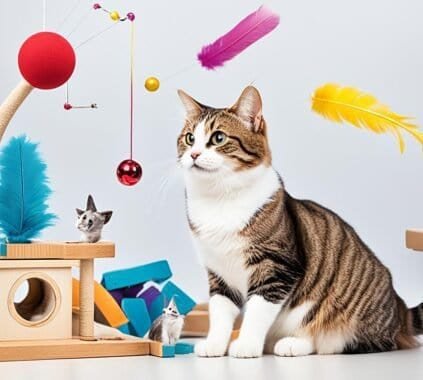Cat litter training is an essential aspect of owning a cat in the Philippines. Whether you have a young kitten or an older cat, proper litter training can help prevent accidents and keep your home clean. In this article, we will provide easy steps and expert tips for successful cat litter training, along with recommendations for the best cat litter options in the Philippines.
Key Takeaways:
- Proper cat litter training is crucial for maintaining cleanliness and preventing accidents in your home.
- Choosing the right litter box and litter is important for successful training.
- Consistency, patience, and positive reinforcement are key factors in training your cat to use the litter box.
- Monitor the cleanliness of the litter box and establish a cleaning routine to encourage regular use.
- If your cat refuses to use the litter box, try troubleshooting the possible causes and consult a veterinarian if necessary.
Finding the Perfect Litter Box for Your Cat
When it comes to cat litter training, finding the perfect litter box is crucial for your furry friend’s comfort and convenience. Consider the following factors to ensure you choose the ideal litter box for your cat:
- Size: Cats come in different sizes, so it’s important to select a litter box that suits your cat’s needs. Kittens may prefer smaller trays, while adult cats may require larger ones to move around comfortably. Providing an appropriately sized litter box can encourage your cat to use it regularly.
- Covered or Uncovered: Decide whether to choose a covered or uncovered litter box. Some cats prefer the privacy provided by a covered litter box, while others may feel more comfortable with an open one. Observe your cat’s behavior to determine which option they prefer.
- Number of Litter Boxes: It is recommended to have at least one litter box per cat in your household. Having multiple litter boxes ensures that each cat has easy access to one when needed. It also helps prevent litter box conflicts between cats.
Remember, finding the perfect litter box is a crucial step towards successful cat litter training. Take your time to consider your cat’s needs and preferences to create a comfortable and inviting space for them.
Placing Litter Box
Proper placement of the litter box is crucial in ensuring successful cat litter training. Cats are meticulous creatures and can be picky about the location of their litter box. By choosing the right spot, you can create a comfortable environment that encourages your cat to use the litter box consistently.
1. Choose a quiet location: Select a space that is tranquil and free from excessive noise or foot traffic. Avoid placing the litter box in high-traffic areas such as hallways or near noisy appliances.
2. Easy accessibility: Ensure that the litter box is easily accessible for your cat. Avoid placing it in corners or closets where cats may feel trapped or uneasy. A corner in a well-ventilated room is generally a good option.
3. Sufficient lighting: Cats prefer to have visibility when using the litter box. Place the litter box in an area where there is enough natural or artificial light, making it easier for them to navigate.
4. Multiple litter boxes: If you have multiple cats or a spacious home, consider placing litter boxes in different areas. This provides cats with convenient options and prevents overcrowding and territorial disputes.
Remember, each cat has its own preferences when it comes to litter box placement. Observe your cat’s behavior and make adjustments as needed to find the ideal location that promotes litter box usage.
Steps to Litter Train a Kitten
Litter training a kitten requires patience and consistency. Follow these steps to effectively train your furry friend:
- Choose the right location: Place the litter box in a quiet area away from your kitten’s food and water. This will create a designated space for your kitten to associate with elimination.
- Provide enough litter: Ensure that the litter box has enough litter to cover the bottom. A depth of about 1-2 inches is ideal for kittens.
- Regularly place the kitten in the litter box: After each meal, gently place your kitten in the litter box. This will help them understand that the litter box is the place for them to relieve themselves.
- Reward good behavior: Whenever your kitten uses the litter box correctly, praise and reward them with a treat or affection. Positive reinforcement will reinforce the desired behavior.
- Monitor for accidents: If your kitten has accidents outside the litter box, clean up the mess without scolding them. Avoid using ammonia-based cleaners as they can attract your kitten back to the same spot.
- Consider litter box adjustments: If your kitten continues to have accidents, consider changing the type of litter or the location of the litter box. Some kittens may have preferences for certain litter textures or box placements.
Remember, consistency and positive reinforcement are key to successful litter training. With time and patience, your kitten will learn to use the litter box reliably.

Steps to Keep the Litter Box Clean
Proper hygiene is key to maintaining a clean and inviting litter box for your cat. By following a few simple steps, you can ensure your cat’s litter box remains fresh and appealing, promoting consistent usage.
- Scoop the litter box daily: Regularly removing waste from the litter box is essential to prevent odors and keep the area clean. Take a few minutes each day to scoop out clumps and solids using a dedicated litter scooper. Dispose of the waste in a sealed bag or trash bin.
- Add new litter as needed: As you remove waste, top up the litter box with fresh litter. A shallow layer of litter, about 2-3 inches deep, is usually sufficient. Consider using a high-quality, dust-free litter to minimize tracking and maintain cleanliness.
- Clean and disinfect the litter box regularly: Even with regular scooping, the litter box requires periodic deep cleaning. Completely empty the litter box and wash it with mild soap and water. Rinse thoroughly to remove all soap residue. To disinfect, use a pet-safe cleaning solution or a mixture of white vinegar and water. Allow the litter box to dry completely before refilling it with fresh litter.
- Change the litter weekly for clumping litter: If you use clumping litter, it’s recommended to completely replace the litter every week. This ensures maximum odor control and hygiene. Dispose of the used litter in a sealed bag or appropriate trash bin.
These simple steps will help you maintain a clean and inviting litter box for your cat. Keeping the litter box clean promotes good litter box habits and encourages your cat to consistently use it for their needs.
“A clean litter box is a happy litter box. By scooping daily, adding new litter, and regularly cleaning and disinfecting the box, you’re creating a hygienic environment that your cat will love.” – Dr. Emily Sullivan, Feline Behavior Specialist
What to Do If Your Cat Refuses to Use the Litter Box
Sometimes, cats may refuse to use the litter box despite proper training. This can be frustrating for cat owners and lead to litter box problems in the home. If your cat is having litter box refusal issues, it’s essential to address the problem promptly and find a solution that works for both you and your furry friend.
Here are some steps you can take if your cat refuses to use the litter box:
1. Double-check the litter box setup
First, ensure that the litter box is easily accessible for your cat. Check if the box is in a quiet and private location, away from any distractions or loud noises. Additionally, make sure the litter box is clean and odor-free. Cats are naturally clean animals and may avoid using a dirty litter box.
2. Consider changing the litter or the litter box type
Cats can be picky about their litter preferences. Experiment with different types of litter to find the one that your cat prefers. Some cats may prefer clumping litter, while others may like non-clumping or natural options. Similarly, try different litter box types, such as covered or uncovered, to see if your cat shows a preference.
3. Scoop the litter box more often
Regularly scooping the litter box can help maintain cleanliness and prevent your cat from refusing to use it. Cats tend to prefer a clean and fresh litter box, so make sure to remove waste and clumps daily. Consider scooping more frequently to ensure a clean environment for your cat.
4. Use pheromone diffusers
Pheromone diffusers can create a calming environment for cats and may help alleviate stress or anxiety that could be causing litter box refusal. These diffusers release synthetic pheromones that mimic the natural calming scents cats produce, helping them feel more secure and confident in their surroundings.
5. Consult a veterinarian
If your cat continues to refuse the litter box despite your best efforts, it’s crucial to consult a veterinarian. There may be underlying medical issues causing your cat’s behavior. The veterinarian can assess your cat’s health and provide guidance or treatment options to address the issue.
By taking these steps and addressing the problem proactively, you can help your cat overcome litter box refusal and restore harmony in your home environment.
Choosing the Right Cat Litter
Choosing the right cat litter is essential for successful litter training. In the Philippines, there are various options available to meet your cat’s needs and preferences. When selecting a cat litter, consider factors such as texture and scent, as these can affect your cat’s comfort and willingness to use the litter box.
Experimenting with different brands and types of litter can help you find the best cat litter for your furry friend. Some popular options include:
- Clay litter: This traditional cat litter is affordable and absorbs moisture effectively.
- Clumping litter: Clumping litter forms solid clumps when wet, making it easier to scoop and maintain cleanliness.
- Natural litter: Made from materials like wood, paper, or corn, natural litters are eco-friendly and often have minimal dust and fragrance.
Remember, every cat has unique preferences, so it may take some trial and error to find the perfect cat litter that encourages proper litter box usage.
By choosing the right cat litter, you’ll create a comfortable environment that promotes good litter habits for your feline companion.

Common Litter Training Challenges and Solutions
Litter training your cat can sometimes present challenges that may require troubleshooting. Cats can be picky about their litter box conditions and may exhibit certain behaviors or preferences that can make the training process difficult. Here are some common litter training challenges and the solutions to overcome them:
1. Picky about Litter Box Conditions
Some cats may show aversion to certain aspects of their litter box, such as the size, texture, or location. If your cat is having difficulty using the litter box, consider the following solutions:
- Ensure the litter box is of an appropriate size that allows your cat to comfortably move and dig.
- Experiment with different types of litter that have varying textures to find the one your cat prefers.
- Place the litter box in a quiet and easily accessible location, away from high-traffic areas or loud noises.
2. Changes in Behavior or Health
Pay close attention to any changes in your cat’s behavior or health during the litter training process. These changes could indicate an underlying issue that requires veterinary attention. If you notice any of the following, consult a veterinarian:
- Increased frequency of accidents outside the litter box
- Significant changes in litter box usage patterns
- Unusual vocalization or discomfort during elimination
- Changes in appetite, thirst, or energy levels
Remember, consistency and patience are key when tackling litter training challenges. With proper adjustments and solutions, you can help your cat develop good litter box habits and ensure a clean and comfortable environment for both you and your feline friend in the Philippines.
Frequently Asked Questions about Cat Litter Training
If you have questions about cat litter training, you’re not alone. Here are some common queries and their answers to help you navigate the process:
Q: How long does it take to litter train a cat?
A: The time it takes to litter train a cat can vary depending on several factors, including the cat’s age, previous experiences, and individual personality. However, with consistent training and positive reinforcement, most cats can learn to use the litter box within a few weeks.
Q: What type of litter is best for training a cat?
A: There are various types of cat litter available, including clay, clumping, and natural options. The best litter for training your cat is one that is easily accessible, comfortable for your cat’s paws, and has minimal dust. Consider your cat’s preferences and experiment with different brands to find the litter that works best for them.
Q: How often should I clean the litter box?
A: It’s essential to keep the litter box clean to encourage your cat to use it consistently. Scoop the litter box at least once a day to remove waste and clumps. Additionally, it is recommended to completely change the litter and clean the box thoroughly on a regular basis, typically once a week.
“Litter training a cat requires patience, consistency, and understanding of your cat’s needs. With time and effort, you can successfully train your cat to use the litter box.”
Q: What should I do if my cat refuses to use the litter box?
A: If your cat is having trouble using the litter box, there could be various reasons. Ensure that the litter box is easily accessible, clean, and in a quiet location. Cats may avoid using the litter box due to stress, medical issues, or a dislike of the litter type. Consulting with a veterinarian can help identify and address any underlying problems.
Q: How can I prevent litter box accidents?
A: To minimize litter box accidents, make sure to keep the litter box clean and accessible at all times. Additionally, provide multiple litter boxes in different areas of your home, especially if you have multiple cats. Observing your cat’s behavior for any signs of distress or changes in bathroom habits can help you address issues before they escalate.
Have more questions about cat litter training? Check out the next section for additional tips and insights.
(Continue reading for more information about cat litter training tips and solutions.)
Conclusion
Litter training your cat is an essential step in responsible pet ownership. By following the right approach, exercising patience, and maintaining consistency, you can successfully train your cat to use the litter box. Remember to choose the right litter box and litter, prioritize cleanliness, and address any challenges or issues that may arise. By implementing these guidelines, you can create a clean and comfortable environment for both you and your furry friend in the Philippines.
Proper litter training not only helps prevent accidents but also promotes a healthier and happier living space for everyone. Remember to consider your cat’s preferences and needs when selecting a litter box and litter. Maintaining cleanliness is also crucial, as cats prefer a clean litter box and are more likely to use it consistently.
Should you encounter any difficulties during the litter training process, such as your cat refusing to use the litter box or exhibiting unusual behavior, don’t hesitate to seek professional advice. Consult with your veterinarian who can provide further guidance and rule out any underlying medical conditions that may be causing these issues.
FAQ
What are the easy steps for cat litter training in the Philippines?
How do I find the perfect litter box for my cat?
Where should I place the litter box?
What are the steps to litter train a kitten?
How do I keep the litter box clean?
What should I do if my cat refuses to use the litter box?
How do I choose the right cat litter?
What are common litter training challenges, and how can I address them?
What are some frequently asked questions about cat litter training?
Last modified: February 20, 2024














[…] There are core and non-core vaccines recommended for cats in the Philippines. […]
[…] cats can be trained to use the litter box, follow basic commands, and even perform impressive tricks. Their trainability and eagerness to […]
[…] following these steps and being patient with your cat, you can help them adjust to their new environment and make the transition smoother for both of […]